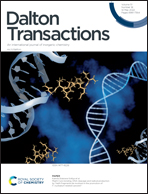Reactivity of superheavy elements Cn and Fl and of their oxides in comparison with homologous species of Hg and Pb, respectively, towards gold and hydroxylated quartz surfaces†
Abstract
Adsorption energies, Eads, and other properties of atoms and oxides of the superheavy elements (SHEs) Cn and Fl, as well as of the homologous species of Hg and Pb, on Au(111) and fully hydroxylated quartz surfaces are predicted on the basis of 2c-DFT calculations and a periodic slab model using BAND software. The ambition of the work is to interpret the outcome of “one-atom-at-a-time” gas-phase chromatography experiments on the reactivity/volatility of SHEs. The present results with an improved (dispersion corrected) exchange–correlation functional show that, in agreement with our earlier predictions and experimental results on Pb, Hg and Cn, the sequence of the Eads values of the atoms on the gold surface should be Pb ≫ Hg > Fl > Cn, with rather moderate Eads values smaller than 90 kJ mol−1 (except for that for Pb). Oxides of Hg, Cn and Fl should be much more reactive with the gold surface than the corresponding atoms, with Eads values of about 200 kJ mol−1. A striking difference in the geometry of the deposited oxides was found between group 12 and group 14. An analysis of the Eads values for M and MO (M = Hg/Cn and Pb/Fl) on the hydroxylated α-quartz surface enables one to conclude that atoms of Hg, Cn and Fl should not interact with such a surface at room temperature, while Pb should adsorb on it. Oxides of these elements, on the contrary, should strongly adsorb on quartz with Eads ≥ 100 kJ mol−1. The present theoretical data agree with the experimental results on the elemental species of Hg, Cn and Fl.



 Please wait while we load your content...
Please wait while we load your content...